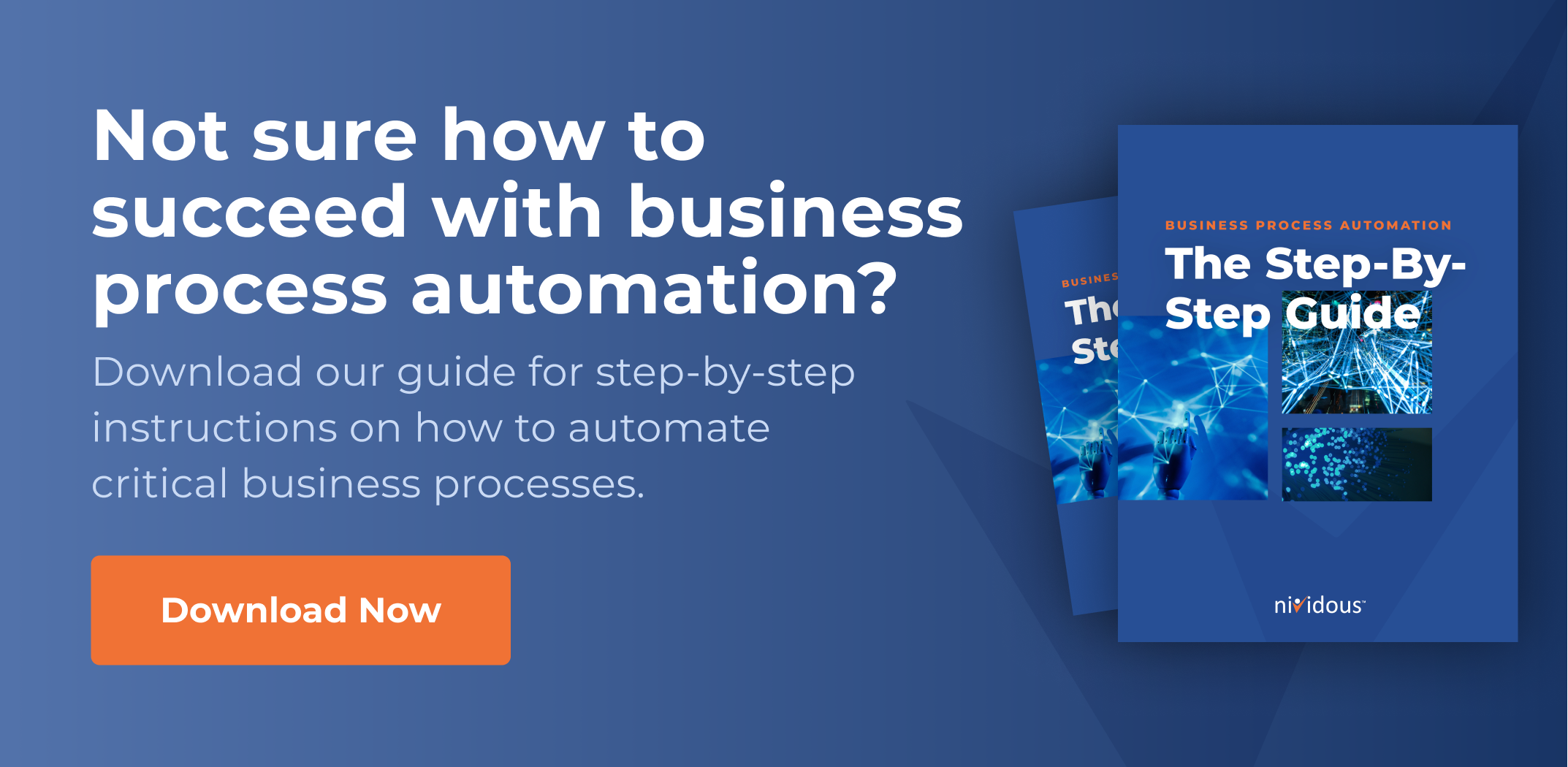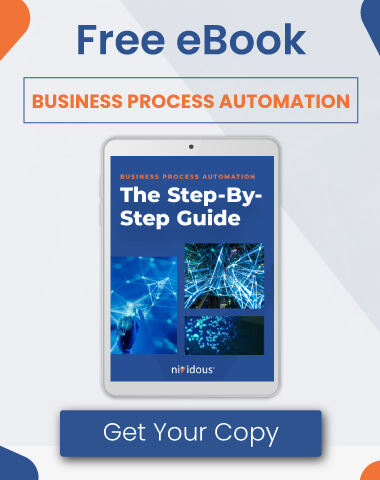Let’s say you run a manufacturing company. What activities does that entail? You must come up with new products. That’s design, engineering, and R&D. You need raw materials—and you need to pay for them. There’s procurement, ordering, inbound logistics, accounts payable. Of course, you also need a revenue stream—accounts receivable, plus sales, marketing, outbound logistics, and more. The list goes on, but that’s probably enough to make our point: Each of these efforts is comprised of a business process. But what are business processes, exactly?
A business process is a series of steps that accomplishes a workplace goal.
The key word here is “series”. Each step in that series is a discrete task. You don’t have a business process until you line up all those tasks into a workflow that achieves a purposeful result. In fact, the simplest (if not the most illuminating) business process definition boils down to one word: work. What if you could accomplish that work faster, more safely, or at a lower cost? That’s the goal of business process optimization—and this optimization is a core part of the end-to-end intelligent automation we offer at Nividous.
In this article, we’ll take our decades of experience optimizing business processes and pare them down to the essentials. We’ll unpack the concept of a business process and offer some common examples. Finally, we’ll provide a simple framework for business process optimization which is the key first step toward digital automation. But even if automation isn’t your end goal, optimizing business processes is the path to a leaner, more effective operation. Here’s how it works.
If you automate a broken process, you’re simply scaling inefficiency.
Nividous helps you both optimize and automate digital business processes. See how the platform works.
Identifying The Major Types of Business Processes: Examples
So far, our definition of business processes has been general and necessarily simplified. The reality of work is complex and interconnected; one process may contain a dozen subprocesses, and all these events may occur simultaneously. It can be hard to pick apart the strands.
The good news is, you already have a schema for organization: Your business itself. Look at your organization chart, and you’ll find your processes at the highest level—though you may need to drill down into departmental structures to find the most helpful processes to optimize.
For instance, many businesses follow a rough outline that looks like this:
- Operations
- Procurement
- Production
- Service
- Shipping and Receiving
- Back Office
- Finance
- Sales
- Marketing
- Human Resources
- Information Technology (IT)
Dig into any one of these departments to see deeper-level processes—and the processes within those processes. Let’s use Finance as an example:
- Finance
- Accounts Payable
- Purchase Orders
- Invoice Processing
- Accounts Payable
-
- Accounts Receivable
- Billing
- Collections
- Accounts Receivable
From there, you can go even deeper—and we’re in no way suggesting things are so simple at your company. But each of these bullets is an example of a business process. Hopefully, this illustrates how your business organization also breaks down into individual processes, any one of which may be ripe for improvement through business process optimization.
Business Process Optimization: The 3-Step Framework
Optimizing business processes is itself a process; that is, we can break the exercise down into a series of steps that introduce a new, better way to complete work. Before we describe those steps we need to define the three major concepts involved in business process optimization.
- An as-is process is the existing way of doing things; it describes the current tasks and procedures in the process you’re studying.
- Key performance indicators (KPIs) quantitatively describe the improvement you’d like to see. There’s no room for vagueness in business process optimization; KPIs give you the metrics you need to evaluate success.
- The to-be process is the new way of doing things. It’s your end goal, an optimized process, and you reach this state by implementing the process improvements you uncover during an optimization exercise.
With these concepts in mind, we’re ready for a step-by-step guide to business process optimization. Note that this is a high-level overview designed to work for everyone. Processes vary from one industry to the next, from one company to another, and even between co-workers. That makes it hard to generalize. This process will work for anyone—but you’ll have to fill in a lot of details to apply them to your unique circumstances. That said, here are the steps:
1. Document the existing process.
Start by analyzing the structure of your as-is process in detail. An as-is process report should include at least the following elements:
- Tasks. What’s each step in the process? Create a workflow map to organize tasks into broader processes.
- Procedures. For each task on your list, how does the work get done? That could be as granular as the series of keystrokes or mouse clicks that move data throughout the process.
- Systems. For most processes today, these will be digital: web-based applications or portals, desktop applications like Excel or Outlook, ERPs, accounting software, etc. But the systems could also include machinery. At any rate, you need to know what tools your team uses to complete each task in the process—and how those tools work with each other.
- People. Who’s completing each task? What sorts of verifications and authorizations are in place at each step? How many Full-Time Equivalent (FTE) hours do you spend on each step? Are all staff following the exact same procedures, or is there a lot of variance to individual approaches?
- Visibility. How does reporting work at every stage of the process? Are you able to collect the data you need to evaluate success or reveal inefficiencies?
Once you have a clear and detailed picture of the as-is process, you can start the analysis.
2. Identify target KPIs.
You probably already have an idea of where you’d like to see improvement. Now it’s time to zero in on the KPIs you can truly adjust by improving this one process. That could be time-to-market, defect rates, internal costs, figures related to pricing or revenue generation; it could be just about anything. Whatever KPIs you choose, make sure they’re directly related to the process at hand. It’s no good to say you want to boost sales when you’re studying a process unrelated to sales, for instance.
We’ve seen a lot of success in improving KPIs related to labor-intensive, data-heavy processes like accounts payable and order management. Strong KPIs in this field include FTE hours, process turnaround time, and operational cost, just to name a few.
3. Identify your model to-be process.
Study your as-is report to see which elements of the process are affecting your chosen KPIs. Establish ideal goals for adjusting these KPIs by modifying discrete elements of the process. You don’t need to choose the exact change you’ll make just yet; you’re starting with a model. But it’s helpful to know what process improvements are available to keep your KPI goals realistic.
Maybe one task is utilizing a huge number of FTEs; that could be a good time to bring in automation. Maybe you spot a simple administrative inefficiency; person A is passing reports to person B, who hands them off to person C without adding much value. In that case, the improvement could be simply removing person B from the chain, reassigning them to a higher-value effort.
Of course, there are countless ways to tweak parameters. You could invest in new software, hire for a new position, automate certain tasks, or even automate whole processes. One tool can help you decide between process improvements: Return on Investment (RoI) analysis (see sidebar). Just remember that in the planning stage, your to-be process is a model of where you’d like to arrive, not necessarily the exact tools you’ll use to get there.
The Central Role Of RoI Calculations In Business Process OptimizationTo transition from an optimization plan to actual implementation, you must choose specific means of improvement. That almost always involves a capital outlay—spending money. With competing means of achieving the same end, the best choice will be the one that offers the fastest or largest return on your investment. That’s why an RoI calculation should be the determining factor in the decision. Many process optimizations end with automation; after all, once you have perfected the process, digital automation takes that improvement to scale. To run an RoI analysis for a digital automation project with Nividous, use our free RoI Calculator. |
With a clear model of your to-be process in hand, you’re ready to start the implementation phase—a subject for another post entirely. Implementing business process optimization is a separate exercise from making the plan, and today, we’re focusing on the planning stage.
If you need help uncovering and implementing business process improvements, however, you’re not alone. Reach out to the experts at Nividous for Business Process Analysis, Business Process Management (BPM) support, and end-to-end intelligent process automation that can make your ideal to-be state a reality.
Click any term below to learn more.
Intelligent Automation
The seamless integration of RPA, AI, and workflow automation tools to automate complex, end-to-end business processes for higher efficiency and agility.
RPA (Robotic Process Automation)
Software bots that replicate human actions to perform rule-based, repetitive tasks with speed and accuracy.
Agentic AI
An advanced form of AI that autonomously makes decisions and takes actions to achieve defined goals without human intervention.
Generative AI
AI models, such as ChatGPT and Gemini, that can create original content—text, images, or code—based on natural language prompts.
Low-Code Platform
A visual development environment that enables users to build applications quickly using drag-and-drop components and minimal coding.
Hyperautomation
A strategic approach that leverages multiple technologies—including RPA, AI, and low-code platforms—to automate business processes end-to-end across the enterprise.






![Business Process Automation: Your Complete Guide [2023]](https://nividous.com/wp-content/uploads/2023/09/Business-Process-Automation-Your-Complete-Guide-2023-Blog-Feature.webp)